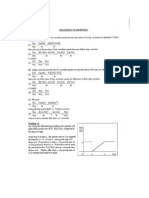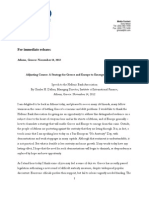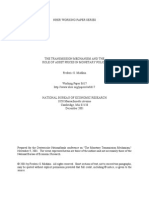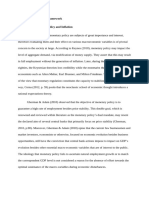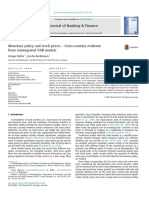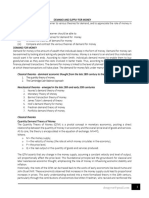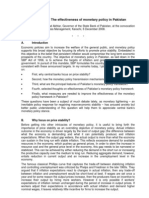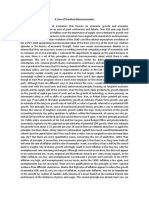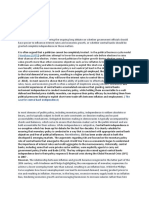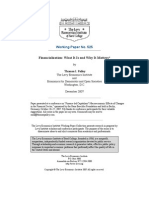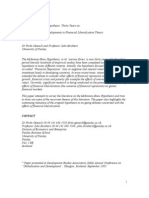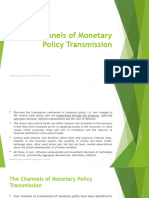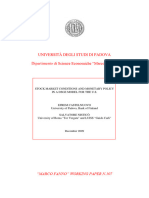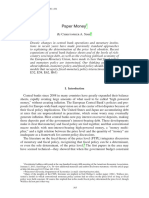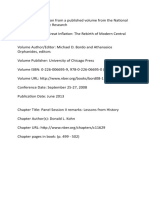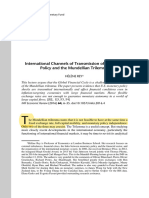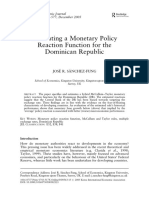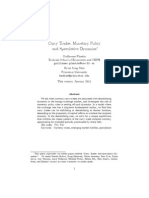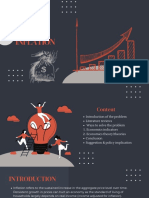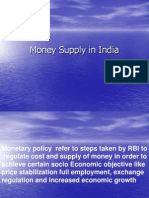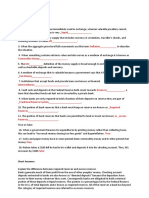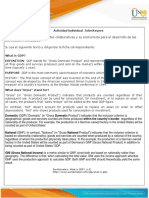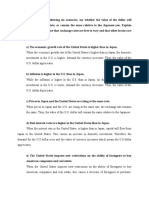0 ratings0% found this document useful (0 votes)
50 viewsSymposium On The Monetary Transmission Mechanism: Frederic S. Mishkin
Symposium On The Monetary Transmission Mechanism: Frederic S. Mishkin
Uploaded by
Abhishek PuriThis document provides an overview of the main transmission mechanisms through which monetary policy affects the economy according to economic literature. It discusses four key transmission mechanisms:
1) The interest rate channel, where monetary tightening raises interest rates, increasing the cost of capital and reducing investment and aggregate demand.
2) The exchange rate channel, where higher domestic interest rates cause currency appreciation, reducing net exports and output.
3) Other asset price effects, like the impact of monetary policy on equity prices (Tobin's q theory) and wealth effects on consumption.
4) The credit channel, involving the impact of monetary policy on bank lending and credit availability, which is discussed in more detail in an accompanying paper by
Copyright:
© All Rights Reserved
Available Formats
Download as PDF, TXT or read online from Scribd
Symposium On The Monetary Transmission Mechanism: Frederic S. Mishkin
Symposium On The Monetary Transmission Mechanism: Frederic S. Mishkin
Uploaded by
Abhishek Puri0 ratings0% found this document useful (0 votes)
50 views9 pagesThis document provides an overview of the main transmission mechanisms through which monetary policy affects the economy according to economic literature. It discusses four key transmission mechanisms:
1) The interest rate channel, where monetary tightening raises interest rates, increasing the cost of capital and reducing investment and aggregate demand.
2) The exchange rate channel, where higher domestic interest rates cause currency appreciation, reducing net exports and output.
3) Other asset price effects, like the impact of monetary policy on equity prices (Tobin's q theory) and wealth effects on consumption.
4) The credit channel, involving the impact of monetary policy on bank lending and credit availability, which is discussed in more detail in an accompanying paper by
Original Description:
fgdfg
Original Title
jep%2E9%2E4%2E3
Copyright
© © All Rights Reserved
Available Formats
PDF, TXT or read online from Scribd
Share this document
Did you find this document useful?
Is this content inappropriate?
This document provides an overview of the main transmission mechanisms through which monetary policy affects the economy according to economic literature. It discusses four key transmission mechanisms:
1) The interest rate channel, where monetary tightening raises interest rates, increasing the cost of capital and reducing investment and aggregate demand.
2) The exchange rate channel, where higher domestic interest rates cause currency appreciation, reducing net exports and output.
3) Other asset price effects, like the impact of monetary policy on equity prices (Tobin's q theory) and wealth effects on consumption.
4) The credit channel, involving the impact of monetary policy on bank lending and credit availability, which is discussed in more detail in an accompanying paper by
Copyright:
© All Rights Reserved
Available Formats
Download as PDF, TXT or read online from Scribd
Download as pdf or txt
0 ratings0% found this document useful (0 votes)
50 views9 pagesSymposium On The Monetary Transmission Mechanism: Frederic S. Mishkin
Symposium On The Monetary Transmission Mechanism: Frederic S. Mishkin
Uploaded by
Abhishek PuriThis document provides an overview of the main transmission mechanisms through which monetary policy affects the economy according to economic literature. It discusses four key transmission mechanisms:
1) The interest rate channel, where monetary tightening raises interest rates, increasing the cost of capital and reducing investment and aggregate demand.
2) The exchange rate channel, where higher domestic interest rates cause currency appreciation, reducing net exports and output.
3) Other asset price effects, like the impact of monetary policy on equity prices (Tobin's q theory) and wealth effects on consumption.
4) The credit channel, involving the impact of monetary policy on bank lending and credit availability, which is discussed in more detail in an accompanying paper by
Copyright:
© All Rights Reserved
Available Formats
Download as PDF, TXT or read online from Scribd
Download as pdf or txt
You are on page 1of 9
Journal of Economic Perspectives Volume 9, Number 4 Fall 1995 Pages 310
Symposium on the Monetary
Transmission Mechanism
Frederic S. Mishkin
B
oth economists and politicians have been heard to advocate in recent years
that the stabilization of output and inflation be left to monetary policy.
Fiscal policy has lost its luster since its heyday in the 1960s, partly because
of concern over persistently large budget deficits, partly because of doubts that the
political system can make tax and spending decisions in a timely way to achieve
desirable stabilization outcomes. Meanwhile, monetary policy has been ever more
at the center of macroeconomic policymaking.
To understand some of the ways that monetary policy can affect the economy,
begin with an arbitrary starting point in the late 1970s, when an overly loose mon-
etary policy is commonly thought to have contributed to the burst of double-digit
inflation in 1979 and 1980. Tight monetary policy engineered by the Federal Re-
serve under the leadership of chairman Paul Volcker broke the back of that infla-
tion, but also dragged the economy into a deep recession. High real interest rates
in the mid-1980s are often linked to the large run-up in the exchange rate value of
the dollar and the resulting temporary decline in competitiveness of American
industry. Lower interest rates then helped extend the economic upswing of the
1980s, and also bring down the dollar exchange rate. But when it seemed that
inflation might be accelerating again in the late 1980s, the Fed tightened once
more. After the recession of 199091, lower interest rates helped the economy
recover. More recently, since early 1994, the Federal Reserve System has raised
Frederic S. Mishkin is Executive Vice President and Director of Research at the Federal
Reserve Bank of New York, New York, New York. He is on leave as the A. Barton Hepburn
Professor of Economics and Finance, Graduate School of Business, Columbia University, New
York, New York. He is also a Research Associate, National Bureau of Economic Research,
Cambridge, Massachusetts.
4 Journal of Economic Perspectives
interest rates to preempt a bout of increased inflation arising from an overheated
economy.
Monetary policy is a powerful tool, but one that sometimes has unexpected or
unwanted consequences. To be successful in conducting monetary policy, the mon-
etary authorities must have an accurate assessment of the timing and effect of their
policies on the economy, thus requiring an understanding of the mechanisms
through which monetary policy affects the economy. These transmission mecha-
nisms include interest rate effects, exchange rate effects, other asset price effects
and the so-called credit channel. This symposium contains papers that should help
acquaint the reader with the explosion of research on how monetary policy is trans-
mitted that has taken place in these last few years. This introduction will provide
an overview of the main types of monetary transmission mechanisms found in the
literature and provide a perspective on how the papers in the symposium relate to
the overall literature and to each other.
The Interest Rate Channel
The transmission of monetary policy through interest rate mechanisms has
been a standard feature in the economics literature for over 50 years. It is the key
monetary transmission mechanism in the basic Keynesian textbook model, which
has been a mainstay of teaching in macroeconomics. The traditional Keynesian
view of how a monetary tightening is transmitted to the real economy can be char-
acterized by a schematic diagram,
M i I Y ,
where M indicates a contractionary monetary policy leading to a rise in real in-
terest rates (i ), which in turn raises the cost of capital, thereby causing a decline
in investment spending (I ), thereby leading to a decline in aggregate demand
and a fall in output (Y ).
Although Keynes originally emphasized this channel as operating through busi-
nesses' decisions about investment spending, later research recognized that con-
sumers' decisions about housing and consumer durable expenditure also are in-
vestment decisions. Thus the interest rate channel of monetary transmission out-
lined in the schematic above applies equally to consumer spending in which I
represents residential housing and consumer durable expenditure. John Taylor's
paper in this symposium argues that the interest rate channel of monetary trans-
mission is a key component of how monetary policy effects are transmitted to the
economy. In his model, contractionary monetary policy raises the short-term nom-
inal interest rate. Then, through a combination of sticky prices and rational expec-
tations, the real long-term interest rate rises as well, at least for a time. These higher
real interest rates lead to a decline in business fixed investment, residential housing
Frederic S. Mishkin 5
investment, consumer durable expenditure and inventory investment, which pro-
duces the decline in aggregate output.
Taylor takes the position that there are strong interest rate effects on consumer
and investment spending and, hence, a strong interest rate channel of monetary
transmission. His position is controversial, as can be seen in the paper in this sym-
posium by Ben Bernanke and Mark Gertler. They state that empirical studies have
had great difficulty in identifying quantitatively important effects of interest rates
through the cost of capital. Indeed, they see the lack of support for a strong interest
rate channel as having provided the stimulus for the search for other transmission
mechanisms of monetary policy, especially the credit channel discussed in their
paper.
The Exchange Rate Channel
With the growing internationalization of the U.S. economy and the advent of
flexible exchange rates, more attention has been paid to monetary policy trans-
mission operating through exchange rate effects on net exports. Indeed, this trans-
mission mechanism is now a standard feature in the leading textbooks in macro-
economics and money and banking. This channel also involves interest rate effects,
because when domestic real interest rates rise, domestic dollar deposits become
more attractive relative to deposits denominated in foreign currencies, leading to
a rise in the value of dollar deposits relative to other currency deposits, that is, an
appreciation of the dollar (denoted by E ). The higher value of the domestic
currency makes domestic goods more expensive than foreign goods, thereby caus-
ing a fall in net exports (NX ) and hence in aggregate output. The schematic for
the monetary transmission mechanism operating through the exchange rate is thus:
M i E NX Y .
Both the Taylor paper and the paper in this symposium by Maurice Obstfeld and
Kenneth Rogoff emphasize the importance of the exchange rate channel of mon-
etary transmission. Both papers emphasize that a framework for the conduct of
monetary policy must be inherendy international in scope.
Other Asset Price Effects
As emphasized by Allan Meltzer in his paper for the symposium, a key mone-
tarist objection to the Keynesian paradigm for analyzing monetary policy effects on
the economy is that it focuses on only one relative asset price, the interest rate, or
in the case of Taylor's model, two interest rates and the exchange rate. Instead,
monetarists hold that it is vital to look at how monetary policy affects the universe
of relative asset prices and real wealth. Monetarists are often loath to commit
6 Journal of Economic Perspectives
themselves to specific transmission mechanisms, because they see these mechanisms
as changing during different business cycles. However, two channels are often em-
phasized in monetarist stories about the monetary transmission mechanism: these
involve Tobin' s q theory of investment and wealth effects on consumption.
Tobin' s q theory provides a mechanism through which monetary policy affects
the economy through its effects on the valuation of equities. Tobin (1969) defines
q as the market value of firms divided by the replacement cost of capital. If q is high,
the market price of firms is high relative to the replacement cost of capital, and
new plant and equipment capital is cheap relative to the market value of business
firms. Companies can then issue equity and get a high price for it relative to the
cost of the plant and equipment they are buying. Thus investment spending will
rise because firms can buy a lot of new investment goods with only a small issue of
equity. On the other hand, when q is low, firms will not purchase new investment
goods because the market value of firms is low relative to the cost of capital. If
companies want to acquire capital when q is low, they can buy another firm cheaply
and acquire old capital instead. Investment spending will be low.
The crux of this discussion is that a link exists between Tobin' s q and invest-
ment spending. But how might monetary policy affect equity prices? In a monetarist
story, when the money supply falls, the public finds it has less money than it wants
and so tries to acquire it by decreasing its spending. One place the public can spend
less is in the stock market, decreasing the demand for equities and consequently
lowering their prices. A more Keynesian story comes to a similar conclusion because
it sees the rise in interest rates coming from contractionary monetary policy making
bonds more attractive relative to equities, thereby causing the price of equities to
fall. Combining these views with the fact that lower equity prices (P
e
) will lead to
a lower q (q ), and thus to lower investment spending (I ), leads to the following
transmission mechanism of monetary policy:
M P
e
q I Y .
An alternative channel for monetary transmission through equity prices occurs
through wealth effects on consumption. This channel has been strongly advocated
by Franco Modigliani and his MIT-Penn-SSRC (MPS) model, a version of which is
currendy in use at the Board of Governors of the Federal Reserve System. In
Modigliani's life-cycle modelexplained very clearly in Modigliani (1971)
consumption spending is determined by the lifetime resources of consumers, which
are made up of human capital, real capital and financial wealth. A major compo-
nent of financial wealth is common stocks. When stock prices fall, the value of
financial wealth decreases, thus decreasing the lifetime resources of consumers,
and consumption should fall. Since we have already seen that contractionary mon-
etary policy can lead to a decline in stock prices (P
e
), we then have another
monetary transmission mechanism:
M P
e
wealth consumption Y .
Symposium on the Monetary Transmission Mechanism 7
Meltzer's contribution to this symposium emphasizes that asset price effects
extend beyond those operating through interest rates, exchange rates and equity
prices. For example, in his description of the Japanese experience in the 1980s and
1990s, monetary policy has an important impact on the economy through its effect
on land and property values. The two channels in the schematics in this section
provide support for this view. A monetary contraction can lead to a decline in land
and property values, which causes households' wealth to decline, thereby causing
a decline in consumption and aggregate output. This is described by the schematic
above in which P
e
also represents land and property values. Tobin's q theory also
applies equally to structures and residential housing so that the schematic outlining
the q-theory mechanism applies. A monetary contraction that leads to a decline in
land and property values lowers their market value relative to replacement cost,
with the resulting fall in their q leading to a decline in spending on structures and
housing.
Credit Channel
As pointed out in the paper by Bernanke and Gertler in the symposium, dis-
satisfaction with the conventional stories about how interest rate effects explain the
impact of monetary policy on expenditure on long-lived assets has led to a new view
of the monetary transmission mechanism that emphasizes how asymmetric infor-
mation and costly enforcement of contracts creates agency problems in financial
markets. Two basic channels of monetary transmission arise as a result of agency
problems in credit markets: the bank lending channel and the balance-sheet
channel.
The bank lending channel is based on the view that banks play a special role
in the financial system because they are especially well suited to deal with certain
types of borrowers, especially small firms where the problems of asymmetric infor-
mation can be especially pronounced. After all, large firms can directly access the
credit markets through stock and bond markets without going through banks. Thus,
contractionary monetary policy that decreases bank reserves and bank deposits will
have an impact through its effect on these borrowers. Schematically, the monetary
policy effect is
M bank deposits bank loans I Y .
Doubts about the importance of the bank lending channel have been raised in the
literaturefor example, after all the financial innovation of the last couple of de-
cades, banks play a less important role in credit markets now than in the 1950s,
1960s or 1970s (Edwards and Mishkin, 1995). This criticism and others are raised
in the symposium papers by Meltzer and by Bernanke and Gertler.
The balance-sheet channel operates through the net worth of business firms
and as emphasized by Bernanke and Gertler, there is no reason to think that it has
8 Journal of Economic Perspectives
become less important in recent years. Lower net worth means that lenders in effect
have less collateral for their loans, and so losses from adverse selection are higher.
A decline in net worth, which raises the adverse selection problem, thus leads to
decreased lending to finance investment spending. Lower net worth of business
firms also increases the moral hazard problem because it means that owners have
a lower equity stake in their firms, giving them more incentive to engage in risky
investment projects. Since taking on riskier investment projects makes it more likely
that lenders will not be paid back, a decrease in business firms' net worth leads to
a decrease in lending and hence in investment spending.
Monetary policy can affect firms' balance sheets in several ways. Contractionary
monetary policy (M ), which causes a decline in equity prices (P
e
) along lines
described earlier, lowers the net worth of firms and so leads to lower investment
spending (I ) and aggregate demand (Y ), because of the increase in adverse
selection and moral hazard problems. This leads to the following schematic for the
balance-sheet channel of monetary transmission:
1
M P
e
adverse selection & moral hazard lending I Y .
The balance-sheet channel provides a further rationale for asset price effects em-
phasized in monetarist thinking.
Contractionary monetary policy that raises interest rates also causes a deteri-
oration in firm's balance sheets because it reduces cash flow. This leads to the
following additional schematic for the balance-sheet channel:
M i cash flow adverse selection & moral hazard
lending I Y .
Although most of the literature on the credit channel focuses on spending by
business firms, Bernanke and Gertler suggest that the credit channel should apply
equally as well to consumer spending. Declines in bank lending induced by a mon-
etary contraction should cause a decline in durables and housing purchases by
consumers who do not have access to other sources of credit. Similarly, increases
in interest rates cause a deterioration in household balance sheets because their
cash flow is adversely affected.
1
If the contractionary monetary policy produces an unanticipated decline in the price level, there is an
additional reinforcement of the balance-sheet transmission mechanism. Because debt payments are con-
tractually fixed in nominal terms, an unanticipated decline in the price level raises the value of firms'
liabilities in real terms (that is, it increases the burden of the debt), but does not raise the real value of
the firms' assets. Monetary contraction, which leads to an unanticipated drop in the price level, therefore
reduces real net worth and causes an increase in adverse selection and moral hazard problems, which
cause a decline in investment spending and aggregate output along the lines of the schematic here. This
is a rationalization of the debt-deflation view of the Great Depression espoused by Irving Fisher (1933).
Frederic S. Mishkin 9
Another way of looking at how the balance-sheet channel may operate through
consumers is in the work on liquidity effects on consumer expenditures on durable
goods and housing, which have been found to be an important factor during the
Great Depression (Mishkin, 1978). In the liquidity-effects view, balance-sheet effects
work through their impact on consumers' desire to spend rather than on lenders'
desire to lend. In this model, if consumers expect a higher likelihood of finding
themselves in financial distress, they would rather be holding fewer illiquid assets
like consumer durables or housing and more liquid financial assets. The underlying
reason is that if consumers needed to sell their consumer durables or housing to
raise money, they would expect to suffer large losses, because they could not get
their full value in a distress sale.
2
In contrast, financial assets like money in the bank,
stocks or bonds can more easily be realized at full market value to raise cash.
This leads to another transmission mechanism for monetary policy operating
through the link between money and equity prices. When falling stock prices reduce
the value of financial assets, consumer expenditures on housing or consumer dur-
ables will also fall, because consumers have a less secure financial position and a
higher estimate of the likelihood of suffering financial distress. Expressed in sche-
matic form,
M P
e
financial assets likelihood of financial distress
consumer durable and housing expenditure Y .
The illiquidity of consumer durables and housing provides another reason why
a monetary contraction that raises interest rates and thereby reduces cash flow to
consumers leads to a decline in spending on consumer durables and housing. A
decline in consumer cash flow increases the likelihood of financial distress, which
reduces the desire of consumers to hold durable goods or housing, thus reducing
spending on them and hence aggregate output. This view of cash-flow effects differs
from the view outlined in the earlier schematic in that it is not the unwillingness
of lenders to lend to consumers that causes expenditure to decline, but the un-
willingness of consumers to spend.
Concluding Remarks
Understanding monetary transmission mechanisms is crucial to answering a
broad range of policy questions. What is the appropriate monetary policy in differ-
ent business cycle episodes? What should be the appropriate rule for monetary
policy? What is the correct choice of a tradeoff between output variability and
2
This is just a manifestation of the "lemons" problem described by Akerlof (1970), which helped stim-
ulate research on the credit channel.
10 Journal of Economic Perspectives
inflation variability? Would a fixed rather than a flexible exchange rate regime
produce better inflation and output outcomes? The papers in this symposium dis-
cuss the research that will help answer these questions.
All opinions expressed are those of the author and not those of Columbia University, the
National Bureau of Economic Research, the Federal Reserve Bank of New York or the Federal
Reserve System. I thank Mark Gertler, Allan Meltzer and Timothy Taylor for helpful comments.
References
Akerlof, George, "The Market for ' Lemons' :
Qualitative Uncertainty and the Market Mecha-
nism," Quarterly Journal of Economics, August
1970, 84:3, 488500.
Edwards, Franklin, and Frederic S. Mishkin,
"The Decline of Traditional Banking: Implica-
tions for Financial Stability and Regulatory Pol-
icy,'' Federal Reserve Bank of New York Economic Pol-
icy Review, July 1995, 1:2, 2745.
Fisher, Irving, "The Debt-Deflation Theory of
Great Depressions," Econometrica, October 1933,
1, 33757.
Mishkin, Frederic S., "The Household Bal-
ance Sheet and the Great Depression," Journal
of Economic History, December 1978, 38:4, 918
37.
Modigliani, Franco, "Monetary Policy and
Consumption." In Consumer Spending and Mone-
tary Policy: The Linkages. Boston: Federal Reserve
Bank of Boston, 1971, pp. 984.
Tobin, James, "A General Equilibrium Ap-
proach to Monetary Theory," Journal of
Money, Credit, and Banking, February 1969, 1,
1529.
This article has been cited by:
1. Yu Hsing. 2005. Impacts of macroeconomic policies on the Latvian output and policy implications.
Applied Economics Letters 12:8, 467-471. [CrossRef]
You might also like
- Advanced Macroeconomics Solutions David RomerDocument266 pagesAdvanced Macroeconomics Solutions David RomerSabin Sadaf91% (34)
- Charles Dallara Speech To The Hellenic Bank AssociationDocument11 pagesCharles Dallara Speech To The Hellenic Bank AssociationCEInquiryNo ratings yet
- Mishkin (1995)Document9 pagesMishkin (1995)Maesley FernandesNo ratings yet
- Monetary Transmission MechanismDocument12 pagesMonetary Transmission MechanismTarun SethiNo ratings yet
- Review Literature of RbiDocument2 pagesReview Literature of RbiAkhil Kulkarni0% (1)
- Monetary Transmission MechanismDocument12 pagesMonetary Transmission MechanismFarhat ImteyazNo ratings yet
- Mishkin 2001-The Transmission Mechanism and The Role of Asset Prices in Monetary PolicyDocument23 pagesMishkin 2001-The Transmission Mechanism and The Role of Asset Prices in Monetary PolicyHải Bình NguyễnNo ratings yet
- W 16755Document63 pagesW 16755Karan SuriNo ratings yet
- Monetary Policy Transmission MechanismDocument29 pagesMonetary Policy Transmission MechanismVenkatesh SwamyNo ratings yet
- Asset Accumulation and Economic ActivityDocument5 pagesAsset Accumulation and Economic ActivityHafiz Saddique MalikNo ratings yet
- Analysis of The Economic Arguments of An Independent Central BankDocument10 pagesAnalysis of The Economic Arguments of An Independent Central BankSanjay PotterNo ratings yet
- DISSERTATIONDocument13 pagesDISSERTATIONNoel GraffixNo ratings yet
- Question: Define and Describe Monetary Analysis and Real Rate of Interest? Monetary AnalysisDocument6 pagesQuestion: Define and Describe Monetary Analysis and Real Rate of Interest? Monetary AnalysisPrecious PearlNo ratings yet
- A Core of Practical MacroeconomicsDocument3 pagesA Core of Practical MacroeconomicsEnrique Alan Lastire OlmedoNo ratings yet
- Ajax Request HandlerDocument42 pagesAjax Request HandlerLucreciad95No ratings yet
- Dynamics of Monetary Policy in EMEs A Case Study of IndiaDocument73 pagesDynamics of Monetary Policy in EMEs A Case Study of IndiaMangala Ghosh100% (2)
- Monetary Policy and Stock Prices - Cross-Country Evidence From Cointegrated VAR ModelsDocument12 pagesMonetary Policy and Stock Prices - Cross-Country Evidence From Cointegrated VAR ModelsThe IsaiasNo ratings yet
- Demand and Supply For MoneyDocument10 pagesDemand and Supply For MoneynderitoaustinNo ratings yet
- Economic Modelling GFDocument35 pagesEconomic Modelling GFAnonymous XR7iq7No ratings yet
- Alavinasab (2016)Document11 pagesAlavinasab (2016)IZMAN GlobalNo ratings yet
- Abstract:: Why Focus On Price Stability?Document11 pagesAbstract:: Why Focus On Price Stability?Farooq SiddiquiNo ratings yet
- Effectiveness of Monetary PolicyDocument8 pagesEffectiveness of Monetary PolicyMiguel SmithNo ratings yet
- Literature Review On Exchange Rate RegimeDocument8 pagesLiterature Review On Exchange Rate Regimegw2cgcd9100% (1)
- A Core of Practical MacroeconomicsDocument5 pagesA Core of Practical MacroeconomicsIZzabel VasquezNo ratings yet
- Nordhaus (1975) : Al. 2018) - in Most Cases It Is Shown That TDocument5 pagesNordhaus (1975) : Al. 2018) - in Most Cases It Is Shown That Trinki84No ratings yet
- 26 Asset Prices in Economic Theory: Ing. Silvia Gantnerová, National Bank of SlovakiaDocument5 pages26 Asset Prices in Economic Theory: Ing. Silvia Gantnerová, National Bank of SlovakianuwanthaNo ratings yet
- Role of MoneyDocument2 pagesRole of MoneyayeshaNo ratings yet
- Research Title:: "The Role of Monetary Policy On Inflation in Developing Country"Document14 pagesResearch Title:: "The Role of Monetary Policy On Inflation in Developing Country"Zaina RathoreNo ratings yet
- Monetary Policy and Economic Growth: An Islamic PerspectiveDocument10 pagesMonetary Policy and Economic Growth: An Islamic PerspectiveDwi Adi MuktiNo ratings yet
- Mishkin 1999bDocument27 pagesMishkin 1999bAndrew TdrNo ratings yet
- Financialization - What It Is - Why It MattersDocument31 pagesFinancialization - What It Is - Why It MattersStefan ErdoglijaNo ratings yet
- Working Paper Series: Money, Banking, and Capital FormationDocument0 pagesWorking Paper Series: Money, Banking, and Capital FormationOmerlatif55No ratings yet
- The Mckinnon-Shaw Hypothesis: Thirty Years On: A Review of Recent Developments in Financial Liberalization Theory by DR Firdu Gemech and Professor John StruthersDocument25 pagesThe Mckinnon-Shaw Hypothesis: Thirty Years On: A Review of Recent Developments in Financial Liberalization Theory by DR Firdu Gemech and Professor John Struthersbabstar999No ratings yet
- Channels of Monetary Policy TransmissionDocument32 pagesChannels of Monetary Policy TransmissionBogdan BoldeaNo ratings yet
- 1 Fisher (1988) Recent Develoments in MacroeconomicsDocument47 pages1 Fisher (1988) Recent Develoments in MacroeconomicsEmily Tomaylla VillagarayNo ratings yet
- NeutralDocument55 pagesNeutralГанболд БЯМБАДАЛАЙNo ratings yet
- Stock Market Conditions and Monetary Policy in ADocument52 pagesStock Market Conditions and Monetary Policy in AAmira TakiNo ratings yet
- Sims 2013 AeaDocument28 pagesSims 2013 Aeaesaamohammad23No ratings yet
- Paper MoneyDocument23 pagesPaper MoneytmscribdNo ratings yet
- Minsky - Financial Instability and The Decline of Banking Oct 1994Document36 pagesMinsky - Financial Instability and The Decline of Banking Oct 1994litespeed09No ratings yet
- Palley 2008Document30 pagesPalley 2008Carmen DurrerNo ratings yet
- 349 394kumhoffDocument46 pages349 394kumhoffCesar Martín PeñaNo ratings yet
- Keynesian and MonetaristDocument9 pagesKeynesian and MonetaristCeaserNo ratings yet
- Monetary Policy Is Not About Interest Rates The Liquidity Effect and The Fisher EffectDocument16 pagesMonetary Policy Is Not About Interest Rates The Liquidity Effect and The Fisher Effectdanieljgallego9No ratings yet
- Working Paper: Exchange Rate EconomicsDocument27 pagesWorking Paper: Exchange Rate Economicssintanurmalah95No ratings yet
- Research On Money and FinanceDocument24 pagesResearch On Money and FinanceMatheus BroettoNo ratings yet
- Article SummariesDocument2 pagesArticle SummariesHamza NaseemNo ratings yet
- Blecker (2003) - Optativo - Financial Globalization TC y Int TradeDocument47 pagesBlecker (2003) - Optativo - Financial Globalization TC y Int TradeCristian SamaniegoNo ratings yet
- Panel Session II Remarks Lessons From HistoryDocument5 pagesPanel Session II Remarks Lessons From History小寺淳人No ratings yet
- Rey 2016Document30 pagesRey 2016Gülşah SütçüNo ratings yet
- Blecker's Critique of Fundamentals-Based International Financial Models by Siya Biniza PDFDocument10 pagesBlecker's Critique of Fundamentals-Based International Financial Models by Siya Biniza PDFSiya BinizaNo ratings yet
- Monetary PolicyDocument18 pagesMonetary Policymodasra100% (2)
- Jose Sanchez Fung - Estimating The Reaction Function of The Monetary Policy in DRDocument16 pagesJose Sanchez Fung - Estimating The Reaction Function of The Monetary Policy in DRAnderson TorresNo ratings yet
- Efficiency of Monetary Policy in Price InstabilityDocument11 pagesEfficiency of Monetary Policy in Price InstabilityHussainul Islam SajibNo ratings yet
- Show Cgi PDFDocument55 pagesShow Cgi PDFEugenio MartinezNo ratings yet
- Chapter 2 PDFDocument16 pagesChapter 2 PDFHayamnotNo ratings yet
- A Layperson's Guide To The Phillips CurveDocument27 pagesA Layperson's Guide To The Phillips CurveMayoukh DuttaNo ratings yet
- Carry Trades, Monetary Policy and Speculative DynamicsDocument39 pagesCarry Trades, Monetary Policy and Speculative DynamicsSherwin RicaflancaNo ratings yet
- The Empirics of Currency and Banking Crises Barry Eichengreen and Andrew RoseDocument14 pagesThe Empirics of Currency and Banking Crises Barry Eichengreen and Andrew RoseFelix NazombeNo ratings yet
- NBER Macroeconomics Annual 2016From EverandNBER Macroeconomics Annual 2016Martin EichenbaumNo ratings yet
- The Mundell-Fleming Economic Model: A crucial model for understanding international economicsFrom EverandThe Mundell-Fleming Economic Model: A crucial model for understanding international economicsNo ratings yet
- PTE Speaking Mock Test 2 PDFDocument49 pagesPTE Speaking Mock Test 2 PDFAbhishek PuriNo ratings yet
- PTE Speaking Mock Test 2 PDFDocument49 pagesPTE Speaking Mock Test 2 PDFAbhishek PuriNo ratings yet
- China "EPA" Crackdown Shuts Down Tens of Thousands of Factories With No End in SightDocument9 pagesChina "EPA" Crackdown Shuts Down Tens of Thousands of Factories With No End in SightAbhishek PuriNo ratings yet
- Retell TemplateDocument1 pageRetell TemplateAbhishek PuriNo ratings yet
- PTE Writing Mock Test 1Document10 pagesPTE Writing Mock Test 1Abhishek PuriNo ratings yet
- 2013 Valuation OlympiadDocument4 pages2013 Valuation OlympiadAbhishek Puri0% (1)
- INCO Terms 2016 - Skyways Management Services LTDDocument9 pagesINCO Terms 2016 - Skyways Management Services LTDAbhishek PuriNo ratings yet
- 159EDM-159EDMM 組合圖Document1 page159EDM-159EDMM 組合圖Abhishek PuriNo ratings yet
- Making Credit Safer: The Case For RegulationDocument5 pagesMaking Credit Safer: The Case For RegulationAbhishek PuriNo ratings yet
- Moving With The Technology: Time and Cost Savings, IncludingDocument2 pagesMoving With The Technology: Time and Cost Savings, IncludingAbhishek PuriNo ratings yet
- Linear Equations: - Linear Equations - Example: Polynomial Interpolation - Applications - Geometrical InterpretationDocument16 pagesLinear Equations: - Linear Equations - Example: Polynomial Interpolation - Applications - Geometrical InterpretationAbhishek PuriNo ratings yet
- Assessing Changes in The Monetary Transmission Mechanism: A VAR ApproachDocument15 pagesAssessing Changes in The Monetary Transmission Mechanism: A VAR ApproachAbhishek PuriNo ratings yet
- Real Options: We Will Maintain Our Highly Disciplined Approach To CapitalDocument32 pagesReal Options: We Will Maintain Our Highly Disciplined Approach To CapitalAbhishek PuriNo ratings yet
- Measuring Country Risk: Executive SummaryDocument5 pagesMeasuring Country Risk: Executive SummaryAbhishek PuriNo ratings yet
- Mixed Economic SystemDocument9 pagesMixed Economic SystemDian GustianiNo ratings yet
- IB Economics Essay Questions P1 2005-2016Document15 pagesIB Economics Essay Questions P1 2005-2016Sidhartha Pahwa50% (2)
- Individual Assignment 1Document4 pagesIndividual Assignment 1Tu NongNo ratings yet
- 6712 Urdu Eng EconomicsDocument12 pages6712 Urdu Eng Economicssyed100% (1)
- PSP 3000 Group 1 InflationDocument23 pagesPSP 3000 Group 1 InflationMUHAMMAD SYAZANI BIN RAZAK / UPMNo ratings yet
- Effects of Strong or Weak EconomyDocument6 pagesEffects of Strong or Weak EconomyJawad Ul Hassan Shah100% (1)
- Money Supply - IndiaDocument20 pagesMoney Supply - IndiaShrey SampatNo ratings yet
- Practice Set 9 AnswersDocument7 pagesPractice Set 9 AnswersRomit BanerjeeNo ratings yet
- VU MBA SyllabusDocument17 pagesVU MBA Syllabussourav.sarkar23-25No ratings yet
- Tutorial Ilmu Ekonomi Sebagai Ilmu SosialDocument1 pageTutorial Ilmu Ekonomi Sebagai Ilmu SosialMayangHemaMalinaNo ratings yet
- Anexo 4. C2 - John KeynesDocument5 pagesAnexo 4. C2 - John KeynesAna María SanchezNo ratings yet
- Applied Economics Week 1Document10 pagesApplied Economics Week 1Asnairah Mala DaraganganNo ratings yet
- Disequilibrium in Balance of PaymentsDocument6 pagesDisequilibrium in Balance of PaymentsAmanda RuthNo ratings yet
- Assignment 10 International Trade Theory and Development StrategyDocument2 pagesAssignment 10 International Trade Theory and Development StrategyAlyssa BerangberangNo ratings yet
- Economic GrowthDocument56 pagesEconomic GrowthJayani UmeshaNo ratings yet
- Price Bubble Indicators by LindtDocument17 pagesPrice Bubble Indicators by LindtOlmedo FarfanNo ratings yet
- 12th Economics Full Study Material English Medium 2022-23Document90 pages12th Economics Full Study Material English Medium 2022-23Lokesh80% (5)
- Chapter 3: Classical Macroeconomics (I) : Output and EmploymentDocument2 pagesChapter 3: Classical Macroeconomics (I) : Output and Employmentsinduration100% (1)
- Leijonhufvud - Sweedish FlagDocument41 pagesLeijonhufvud - Sweedish FlagJuan O Antezana BNo ratings yet
- Hair Care in Asia PacificDocument64 pagesHair Care in Asia PacificQuỳnh PhươngNo ratings yet
- Phelps Lecture2006Document26 pagesPhelps Lecture2006Tuan HoangNo ratings yet
- The Effects of Fiscal Policy On Private Business InvestmentDocument2 pagesThe Effects of Fiscal Policy On Private Business InvestmentT uohzNo ratings yet
- CV VieyraDocument2 pagesCV Vieyraapi-436715485No ratings yet
- If Tut 4Document7 pagesIf Tut 4Ong CHNo ratings yet
- Introduction To International EconomicsDocument1 pageIntroduction To International EconomicsAkansha guptaNo ratings yet
- Indian Financial System ProjectDocument21 pagesIndian Financial System Projectali100% (1)
- 12 Commerce - 2nd Unit TestDocument3 pages12 Commerce - 2nd Unit Testsushilprajapati10_77No ratings yet
- The Conduct of Monetary Policy: Strategy and TacticsDocument26 pagesThe Conduct of Monetary Policy: Strategy and TacticsRakib HasanNo ratings yet
